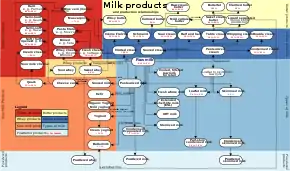Dairy product
Dairy products or milk products are a type of food produced from or containing the milk of mammals, most commonly cattle, water buffaloes, goats, sheep, and camels. Dairy products include food items such as yogurt, cheese and butter.[1][2] A facility that produces dairy products is known as a dairy, or dairy factory.[3] Dairy products are consumed worldwide, with the exception of most of East and Southeast Asia and parts of central Africa.[4]


Types of dairy product
Milk


Milk is produced after optional homogenization or pasteurization, in several grades after standardization of the fat level, and possible addition of the bacteria Streptococcus lactis and Leuconostoc citrovorum. Milk can be broken down into several different categories based on type of product produced, including cream, butter, cheese, infant formula, and yogurt.
Milk varies in fat content. Skim milk is milk with zero fat, while whole milk products contain fat.
- Scalded milk
- Condensed milk, milk which has been concentrated by evaporation, with sugar added for reduced process time and longer life in an opened can
- Evaporated milk, (less concentrated than condensed) milk without added sugar
- Baked milk is milk simmered on low heat for long time which results in mild caramelization. Particularly popular in Eastern Europe.
- Dulce de leche
- Malai
- Powdered milk (or milk powder), produced by removing the water from (usually skim) milk
- Khoa, milk which has been completely concentrated by evaporation, used in Indian cuisine
- Infant formula, dried milk powder with specific additives for feeding human infants
- High milk-fat and nutritional products (for infant formulas)
- Whey, the liquid drained from curds and used for further processing or as a livestock feed
- Buttermilk, the liquid left over after producing butter from cream, often dried as livestock feed
- Milk skin
Fermented milk
- Soured milk obtained by fermentation with mesophilic bacteria, mainly Lactococcus lactis and other bacterial cultures and yeasts
- Cultured buttermilk resembling buttermilk, but uses different yeast and bacterial cultures
- Clabber, milk naturally fermented to a yogurt-like state
- Filmjölk
- Ymer
- Viili
- Kefir, fermented milk drink from the Northern Caucasus
- Kumis, fermented mares' milk popular in Central Asia
- Amasi
- Mursik
Yogurt
Yogurt, milk fermented by thermophilic bacteria, mainly Streptococcus salivarius ssp. thermophilus and Lactobacillus delbrueckii ssp. bulgaricus sometimes with additional bacteria, such as Lactobacillus acidophilus
Cream
- Single cream, double cream and whipped cream
- Clotted cream, thick, spoonable cream made by heating milk
- Kaymak
- Sour cream
- Smetana, Central and Eastern European variety of sour cream
- Crème fraîche, slightly fermented cream
Butter
Butter, mostly milk fat, produced by churning cream
- Ghee also called, clarified butter, by gentle heating of butter and removal of the solid matter
- Smen, a fermented, clarified butter used in Moroccan cooking
- Anhydrous milkfat (clarified butter)
Cheese
Cheese, produced by coagulating milk, separating from whey and letting it ripen, generally with bacteria and sometimes also with certain molds.
- Rennet-coagulated cheeses
- Acid-set or sour milk cheeses
- Fresh cheeses and curds, the soft, curdled part of milk (or skim milk) used to make cheese
- Chhena and Paneer
- Cream cheese, produced by the addition of cream to milk and then curdled to form a rich curd or cheese
- Whey cheese is a dairy product made from whey and thus technically not cheese.
- Heat and acid coagulation
- Ricotta, acidified whey cheese
- Manouri, anthotyros, mizithra from Greece.
- Brown cheese made of boiled-down whey
- Heat and acid coagulation
Casein
- Caseinates, sodium or calcium salts of casein
- Milk protein concentrates and isolates
- Whey protein concentrates and isolates, reduced lactose whey
- Hydrolysates, milk treated with proteolytic enzymes to alter functionality
- Mineral concentrates, byproduct of demineralizing whey
Custard
- Custard, thickened with eggs
- Imitation custard, thickened with starch
Ice cream

- Ice cream, slowly frozen cream, milk, flavors and emulsifying additives (dairy ice cream)
- Gelato, slowly frozen milk and water, lesser fat than ice cream
- Ice milk, low-fat version of ice cream
- Frozen custard
- Frozen yogurt, yogurt with emulsifiers
Health
Dairy products can cause problems for individuals who have lactose intolerance or a milk allergy.[5][6] People who experience lactose intolerance usually prefer to avoid milk and other lactose-containing dairy products, as they may cause symptoms such as abdominal pain, bloating, diarrhea, gas, and nausea. Milk treated to be lactose free offers an alternative.
Excessive consumption of dairy products can contribute significant amounts of cholesterol and saturated fat to the diet, which can increase the risk of heart disease, and cause other serious health problems.[7]
There is no excess cardiovascular risk with dietary calcium intake, but calcium supplements are associated with a higher risk of coronary artery calcification.[8]
Consumption of dairy products does not cause mucus production, and will not make cold or asthma symptoms worse.[9] This widely held belief stems from some people mistaking the thin coat of residue left behind after consuming milk or ice cream for mucus.[10]
Consumption patterns worldwide
Rates of dairy consumption vary widely worldwide. High-consumption countries consume more than 150 kg per capita per year. These countries are: Argentina, Armenia, Australia, Costa Rica, most European countries, Israel, Kyrgyzstan, North America and Pakistan. Medium-consumption countries consume 30 to 150 kg per capita per year. These countries are: India, Iran, Japan, Kenya, Mexico, Mongolia, New Zealand, North and Southern Africa, most of the Middle East, and most of Latin America and the Caribbean. Low-consumption countries consume under 30 kg per capita per year. These countries are: Senegal, most of Central Africa, and most of East and Southeast Asia.[4][11]
Avoidance on Principle
Some groups avoid dairy products for non-health-related reasons:
Religious – Some religions restrict or do not allow for the consumption of dairy products. For example, some scholars of Jainism advocate not consuming any dairy products because dairy is perceived to involve violence against cows.[12] Orthodox Judaism requires that meat and dairy products not be served at the same meal, served or cooked in the same utensils, or stored together, as prescribed in Deuteronomy 14:21.[13]
Vegans – Veganism is the avoidance of all animal products, including dairy products, most often due to the ethics regarding how dairy products are produced. The ethical reasons for avoiding meat and dairy products include how dairy is produced, how the animals are handled, and the environmental effect of dairy production.[14][15] According to a report of the United Nations’ Food and Agriculture Organization in 2010 the dairy sector accounted for 4 percent of global man-made greenhouse gas emissions.[16][17]
See also
References
- "Dairy | Clemson University, South Carolina". www.clemson.edu. Archived from the original on 31 December 2016. Retrieved 11 November 2016.
- "Is Butter a Dairy Product, and Does it Contain Lactose?". Authority Nutrition. 1 July 2016. Archived from the original on 28 January 2017. Retrieved 11 November 2016.
- "Definition of DAIRY". www.merriam-webster.com. Archived from the original on 30 October 2016. Retrieved 29 October 2016.
- Food and Agriculture Organization of the United Nations, "Dairy production and products: Milk and milk products" Archived 27 October 2016 at the Wayback Machine
- "Lactose intolerance". Genetics Home Reference. 8 February 2016. Archived from the original on 25 January 2016. Retrieved 12 February 2016.
- "Milk Allergy – Food Allergy Research & Education". www.foodallergy.org. Archived from the original on 8 February 2016. Retrieved 12 February 2016.
- "Saturated Fat". Archived from the original on 16 June 2016. Retrieved 16 June 2016.
- Anderson JJ, Kruszka B, Delaney JA, et al. (October 2016). "Calcium intake from diet and supplements and the risk of coronary artery calcification and its progression among older adults: 10-year follow-up of the Multi-Ethnic Study of Atherosclerosis (MESA)". J Am Heart Assoc. 5 (10): e003815. doi:10.1161/jaha.116.003815. PMC 5121484. PMID 27729333.
- Pinnock, CB; Graham, NM; Mylvaganam, A; Douglas, RM (1990). "Relationship between milk intake and mucus production in adult volunteers challenged with rhinovirus-2". The American Review of Respiratory Disease. 141 (2): 352–56. doi:10.1164/ajrccm/141.2.352. PMID 2154152.
- Michigan Dairy Review "Ten Common Myths about Dairy Foods Zey Ustunol Dept. of Food Science and Human Nutrition https://msu.edu/~mdr/vol15no2/myths.html Archived 6 January 2017 at the Wayback Machine
- "WHO | 3. Global and regional food consumption patterns and trends". WHO. Archived from the original on 12 March 2019. Retrieved 18 March 2019.
- Wiley, K.L. (2004). Historical Dictionary of Jainism. Historical Dictionaries of Religions, Philosophies, and Movements Series. Scarecrow Press. p. 78. ISBN 978-0-8108-6558-7. Retrieved 15 April 2019.
In recent times, out of concern for the treatment of cows in commercial dairy farming, some Jains in the diaspora and in India now observe a vegan diet and discourage the use of dairy products in temple rituals.
- "Kosher and Halal". Archived from the original on 17 March 2018.
- "Ethical Reasons to Give Up Dairy Products – dummies". dummies. Archived from the original on 2 February 2017. Retrieved 21 January 2017.
- "My year of eating ethically". The Independent. 30 June 2010. Archived from the original on 29 September 2017. Retrieved 21 January 2017.
- "Dairy sector adds 4 percent to man-made emissions: FAO". Reuters. 20 April 2010. Retrieved 9 May 2019.
- Moskin, Julia; Plumer, Brad; Lieberman, Rebecca; Weingart, Eden; Popovich, Nadja (30 April 2019). "Your Questions About Food and Climate Change, Answered". The New York Times. ISSN 0362-4331. Retrieved 10 May 2019.
Further reading
- Fuquay, John W. ed. Encyclopedia of Dairy Sciences (2nd Edition, 4 vol 2011), comprehensive coverage
- Rankin, H. F. (1922) Imbucase: the Story of the B. C. I. C. of the Ministry of Food. Edinburgh: Edinburgh Press (B.C.I.C.=Butter and Cheese Imports Committee)
External links
| Wikibooks Cookbook has a recipe/module on |


